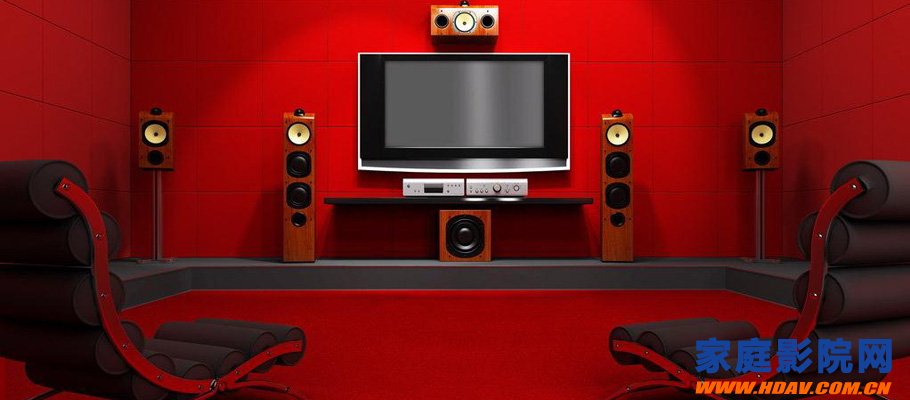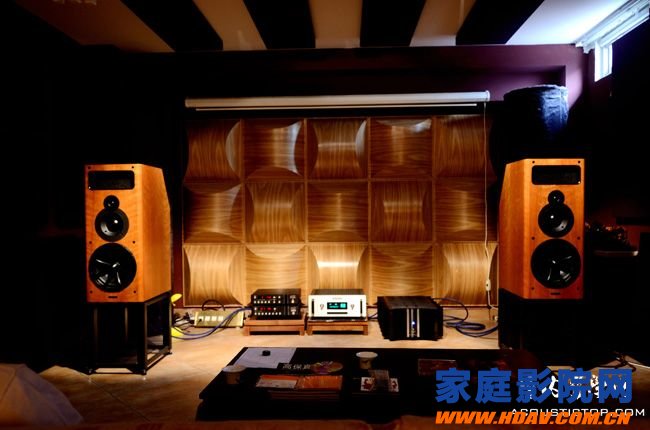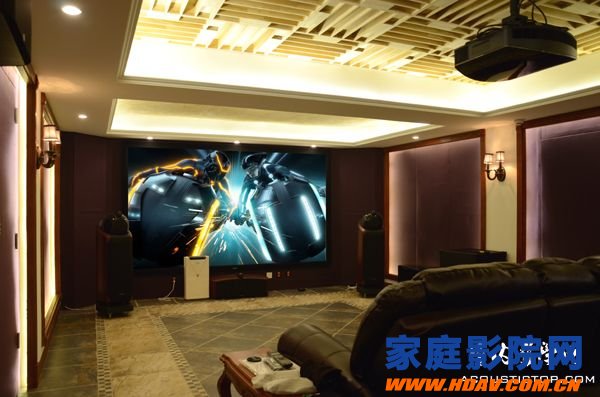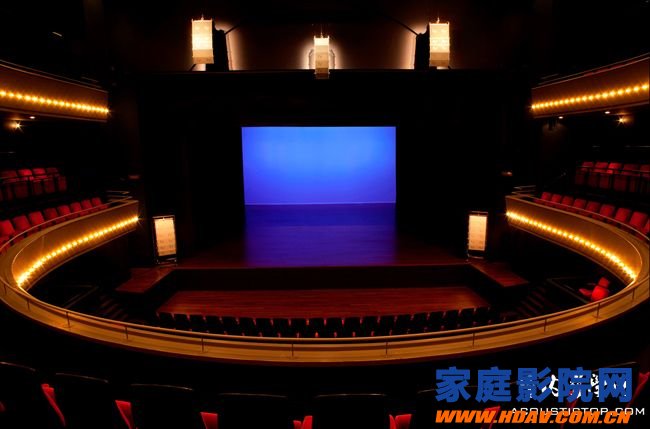[Home Theater Network HDAV.com.cn] When purchasing audio, the salesperson usually asks you: "Are you using AV or HI-FI?" AV is the English word audio (audio signal) and video (video signal) head. A letter co-writing; HI-FI is an abbreviation for English "high fidelity." In fact, the salesperson means to know if you are installing a sound system for home theater or purely for listening to music, and it also implies that AV (home theater) and HI-FI (listening to music only) have different audio requirements. HIFI stereo enthusiasts always discriminate against the performance of multi-channel home theater systems during music playback. So is this really true? What is the cause? Let's take an example for analysis. A set of 50,000 yuan stereo Hi-Fi system PK set of 50,000 yuan 5.1 channel home theater audio system. The stereo system is relatively simple: 2 speakers, 1 CD player, 1 amplifier, a total of 4 devices plus some wires. The home theater audio system has more equipment, 6 speakers, 1 AV amplifier, 1 Blu-ray player, a total of 8 devices plus some wires. Arithmetic questions everyone should do: The average price of the equipment in the stereo system = 50000/4 = 12,500 yuan (excluding the wire) The average price of home theater equipment = 50000/8 = 6250 yuan (excluding wire) If the influence of factors such as branding is taken, the quality of cinema equipment should not be as good as that of stereo equipment. Stereo products have relatively simple electronic circuits and few components. On the basis of high price, stereo manufacturers can use very good audio components. Most of the ordinary cinema products are large-scale mass production products, complex electronic circuits, and a wide range of components (video processing + multi-channel audio), but also costly expensive Dolby/DTS/THX/SONY Blu-ray patent fees (amplifiers) And Blu-ray machines have to pay), you think, AV manufacturers can use high-quality audio components? If each resistor and capacitor are inferior, the crossover and speaker unit are a few more, then accumulate That is a far cry. In addition, when playing music, generally everyone will take the CD to compare. The CD is recorded in two channels, which is naturally the most accurate when the two channels are restored. If you use the AV amplifier's Pro Logic II or Pro Logic IIx to convert to 5.1 or 7.1 channels to listen, the accuracy of the restore is definitely worse. So, you can understand why many stereo enthusiasts don't like to listen to stereo music in multi-channel mode. However, even if the AV amplifier is set to 2.0 pass-through (turn off the subwoofer), or 2.1 mode (turn on the subwoofer), the difference in the quality of the amplifier audio component and the speaker unit will still cause the multi-channel system to play the two-channel music. Not a two-channel system like the price. But when you come back and think about it, is this PK based on a fair and just competitive platform? If it is really PK sound quality, I think the total value of the 5.1/7.1 system should be at least 150,000 yuan (everyone uses the same factory) In the same series of products, the audio components of the electronic products are basically the same quality, and the program to be played should be the stereo version and the multi-channel version of the same program. Such a PK is considered to be fair. Can multi-channel system be HIFI? Hi-Fi is the abbreviation of English High-Fidelity, literally translated as "high fidelity", which is defined as: a replay sound that is highly similar to the original sound. So what kind of audio equipment is the sound of Hi-Fi? It is still difficult to draw a definitive conclusion. Professionals in the audio industry use various instruments to detect various indicators to determine the level of Hi-Fi equipment. Audiophiles often use their own ears to determine whether the equipment meets Hi-Fi. . Judging the high fidelity of the playback sound requires not only equipment and software with excellent performance, but also a good listening environment. Therefore, how to correctly measure the Hi-Fi level of audio equipment, there are still differences between objective test and subjective evaluation. So what is the meaning of high fidelity? What is the high fidelity? From the perspective of music reproduction and playback, it is divided into the following two cases: 1) The feeling of listening to music at home is basically the same as listening to the concert. 2) The feeling of listening to music at home is basically the same as that of the recording engineer who recorded this CD. Is the first situation possible? Unfortunately, it is completely impossible, and it is difficult to get close. why? Concert live performances (such as the symphony orchestra playing in the concert hall) have the following characteristics (taken from Dr. Floyd Toole's book): 1) The sound source is multi-directional (when the violin is playing a certain frequency of sound, the sound wave radiation is actually vertical upwards, many people don't know?), the sound waves radiate in all directions, most of the sound sources Are far from the audience. When the violin plays different melody, the radiation angle of the sound waves is very inconsistent, forming a stereoscopic 3D sound field before and after the up, down, left and right. Your home's speakers, even if you have a pair of 100 million yuan, can you produce a vertical high frequency when playing a violin? Even if some speakers have a high-frequency "mushroom head" installed on the top, your speakers can radiate at different angles. Is the sound wave of frequency? 2) The perception of tone, space and envelopment generated by room reflection is the main way for listeners to feel the music (meaning that the reflected sound dominates) The other three features are omitted here. Interested enthusiasts can check the relevant information themselves. The key point mentioned by the Ph.D. is that behind the band in the concert hall, there is usually a large reflecting plate. This large reflecting plate mixes the sounds of the band and then pushes them to the performers and the first few. Row of spectators. The 3D sound field formed by this reflection is extremely complicated, and the two strong directional speakers used in the home are completely unable to restore the sound field effect of the appearing field. The use of multiple speakers combined with multi-channel recording soundtracks does not restore the complex 3D sound field, but the addition of center and surround channels enhances the perception of the audience's tone, sense of space and surround. From this perspective, multichannel systems are superior to stereo systems. Does traditional stereo listening pay attention to the "phantom image" effect? ​​That is to say, people sitting in the middle of two speakers can hear the singer's sound image positioning just in front of you. However, if there is a dedicated center speaker, the positioning of the middle sound image does not drift, who cares about the phantom effect that disappears at that time? We don’t forget, a few decades ago, scientists wanted to use three speakers. In addition, the surround channel can play the ambient sound, which greatly enhances the sense of envelopment and presence. Also, 5.1 recordings are also equipped with LFE low-frequency effects channels, and the potential and peak reserves at low frequencies also exceed stereo recording! Why are most home theaters not good at listening to music? A: Several possible factors - acoustic environment, equipment placement, seat position, equipment quality, commissioning, recording program quality. All of these links that may affect the sound quality will be analyzed in the following chapters, and then the fans can clearly know where the problem of their system is, and then prescribe the right medicine. Ok, let's take a look at point 2. Unfortunately, whether it's a multi-channel system or a stereo system, you can't be sure if the CD effect you've heard is the same as when you recorded it. A scientist tested 250 stereo studios around the world and tested the far-field frequency response curve of the monitor speakers at the position of the sound engineer. How big is the difference, especially in the low frequency area (equipment debugging and room low frequency standing waves will cause similar problems). These studios use similar or similar professional recording equipment. Imagine if the sound engineer could not hear the low frequency of a certain band (such as the bottom curve) while recording, in order to achieve sufficient listening loudness, he would have to record more low frequencies when recording. Then when you restore this CD in your home, you feel that the low frequency is very "hypertrophic", then it may not be your home equipment or debugging problems?? When THX set the THX Music mode a few years ago, it tried to collaborate with the music recording industry to seek standardization. Later, it found that the industry had no standards at all, so it gave up the plan. A small experiment can find that the music recording industry is seriously lacking in standards. For example, if you play different CDs, in order to achieve satisfactory listening loudness, is the volume position of the amplifier often adjusted? However, you play several Dolby Digital continuously. The movie program of the track, you will find that the master volume is generally in the same position. This experiment shows that the recording reference level of CD is different for each company, there is no standard at all! The sound of loud sound is completely determined by the audience. When did you see that stereo enthusiasts used a Radio Shack sound pressure meter to calibrate the sound level of the stereo system? Even with a test instrument, how many decibels do you need to adjust the volume to the standard? Friends know that the pink noise in the AV amplifier is used to calibrate the 75dBc movie sound level. In foreign countries, many manufacturers of stereo Hi-Fi devices tend to use CDs from well-known large companies such as Telarc, EMI, etc. when demonstrating equipment. Who knows the CD from a small company? However, the film industry is standard! As long as the funds are strong enough, you can hear the same professional technical indicators when you build the audio-visual room, you can hear the same effect as Spielberg heard. More fresh and fun home theater information, please pay attention to home theater network http:// (WeChat: cnhifi), the country's most influential home theater audio player interactive media website. Note: This article is transferred from love video. The article is an independent view of the author and does not represent the position of the home theater network. Dongguan Guancheng Precision Plastic Manufacturing Co., Ltd. , http://www.dpowerchargers.com



November 22, 2024